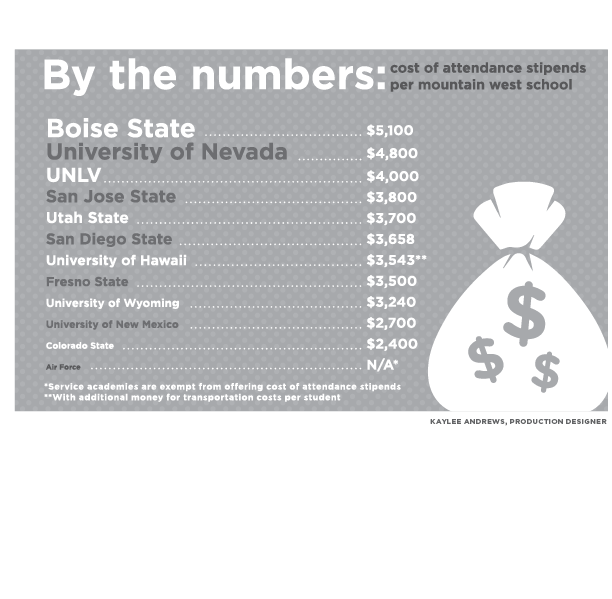Ten months ago the NCAA voted to approve a measure that requires the Power Five conferences to cover the full cost of attendance for scholarship student-athletes.
So far this historic vote has raised more questions than answers, but here’s what is constant: The additional money comes as part of a cost of attendance stipend that student-athletes receive each semester.
It is in addition to the money student-athletes receive as part of the full grant and aid.
The cost of attendance stipend is calculated by adding together the transportation and miscellaneous costs calculated by each university’s financial aid department.
The money for these stipends comes out of the university’s scholarship fund.
The resolution means more money for student-athletes who have been pushing to get compensation from universities profiting off of their exploits.
However, there is little regulation of the process by which the financial aid departments calculate the estimates for transportation and miscellaneous costs.
This results in a wide range of money that different schools around the Mountain West can offer athletes, and that creates an unanswered question of what effect these stipends will have on college recruiting.
Jake Garlock, assistant athletics director of compliance at Utah State, said he thinks coaches will talk about their cost of attendance stipend numbers when meeting with recruits.
“Coaches are professional recruiters and they know how to make their universities sound appealing to recruits,” he said.
“There are going to be competitive aspects to it,” said Chris Collins, San Diego State’s associate director of financial aid. “If school A can offer more money than school B, then that gives them a recruiting advantage.”
Boise State has the highest cost of attendance stipend among MW schools at $5,100.
The disparity can be traced to the school’s estimate of miscellaneous costs, which, at $3,182, is about $1,800 higher than Colorado State — the MW university with the lowest cost of attendance number, $2,400, and a miscellaneous cost estimate of $1,360.
There is no regulation for what is included in miscellaneous costs, but most universities estimate based on laundry, food and toiletries.
Some universities take a survey of students’ miscellaneous spending habits and some universities base their calculation on the consumer price index and U.S. Bureau of Labor statistics for the state.
It’s entirely up to each financial aid department to come up with an estimate of the cost of attendance.
“Every institution could look at these (figures) in a different way,” said Chuck Lang, SDSU associate athletic director of business administration. “The situations are different, the institution’s goals are different (and) they may have regulations that are different.”
The federal government tracks colleges’ cost of attendance numbers and colleges must justify the amounts in some way.
Collins said the Chancellor’s office for the California State University system set a standard miscellaneous cost estimate of $1,392 in 2013 for all CSU schools.
This miscellaneous cost estimate includes only education expenses and doesn’t factor in entertainment costs for students, such as phone bills, cable expenses and weekly spending money.
The difference in cost of attendance stipend money between CSU schools is based on the estimated transportation costs for each student.
Universities typically have four different cost of attendance stipend numbers based on whether the scholarship student-athlete is a resident or an out-of-state student living on or off campus.
Diana Fairchild, director of financial aid at Boise State, said to get the estimate for transportation costs her department looks at prices for a roundtrip flight to various places including California, Alaska and Colorado, and averages the cost of the tickets.
“You’ll find a lot of different ways schools calculate those costs, we are all doing it independently,” Fairchild said. “It’s not that there is one right and one wrong to calculate it. Now only because of schools opting to pay athletes it’s become an issue.”
Fairchild said Boise State includes entertainment costs in its estimates for miscellaneous costs.
The miscellaneous cost estimate plays a role in determining the amount of money schools can give athletes as part of the cost of attendance stipend.
But it also determines how much students are owed through the Pell Grant and how much students are allowed to take out in federal loans.
The establishment of the stipend could put a strain on the relationship between the financial aid and athletic departments because financial aid departments have traditionally tried to keep their cost of attendance estimates as low as possible.
Now the higher the number is for transportation and miscellaneous costs, the more money athletic departments can give to scholarship student-athletes.
University of Nevada Financial Aid Director Tim Wolfe said his department has weekly meetings with the athletic department to discuss various matters including the cost of attendance stipend.
Nevada offers the second-largest cost of attendance stipend in the MW at $4,800 and its miscellaneous cost estimate is $2,500.
Lang said the food needs of student-athletes are often higher than the university calculates and the cost of attendance stipend is there to help with those costs.
“We can ask questions and bring things up that are of concern to us, but we’re just one voice of that,” Lang said. “We want it to be accurate for everybody, which is the important part.”
As far as athletic departments influencing financial departments’ cost of attendance numbers, Garlock is skeptical.
“I don’t know that you would be able to prove (athletic departments influence financial aid calculations) for any particular school,” he said. “Sometimes you look at those numbers and it kind of raises an eyebrow.”












